Pneumonia Case Study: Ibrahim's Diagnosis, Assessment, and Care Plan
VerifiedAdded on 2022/09/08
|11
|2841
|24
Case Study
AI Summary
This case study focuses on a patient, Ibrahim, diagnosed with community-acquired pneumonia. It details the nursing assessment process, including airway, breathing, and circulation evaluations, and the prioritization of care. The assessment covers vital signs, history, and physical examination, including ABG measurements. The study highlights symptoms like painful breathing, wheezing, and tachypnea, linking them to potential causes and diagnostic methods like chest radiography. It also explores the patient's history of smoking as a risk factor. The assignment further outlines nursing interventions such as oxygen therapy, airway clearance, fluid balance optimization, pain management, and nutritional support, emphasizing the importance of prompt antibiotic administration and continuous patient monitoring. The case study provides insights into the complexities of pneumonia management and the crucial role of nurses in providing effective patient care.
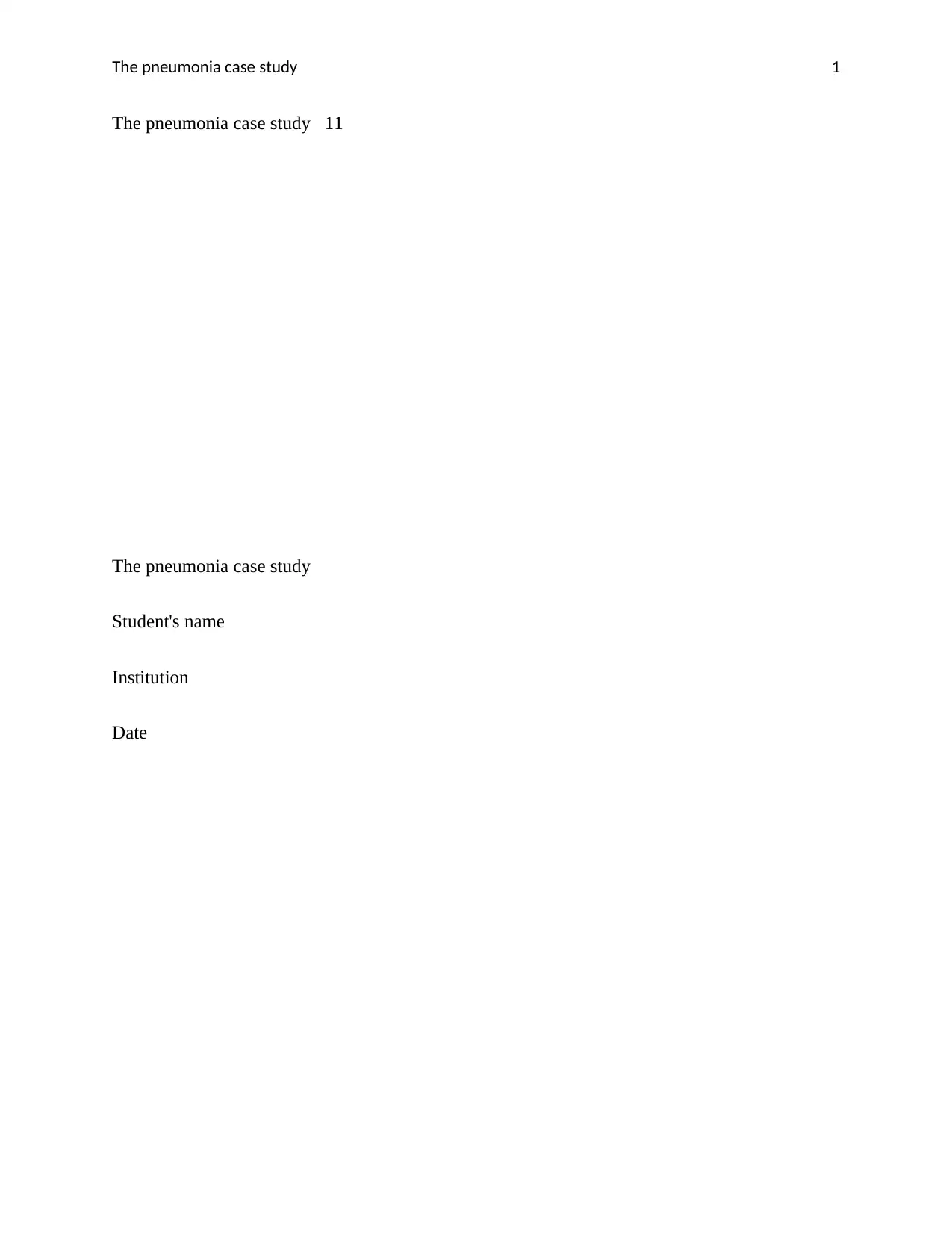
The pneumonia case study 1
The pneumonia case study 11
The pneumonia case study
Student's name
Institution
Date
The pneumonia case study 11
The pneumonia case study
Student's name
Institution
Date
Paraphrase This Document
Need a fresh take? Get an instant paraphrase of this document with our AI Paraphraser
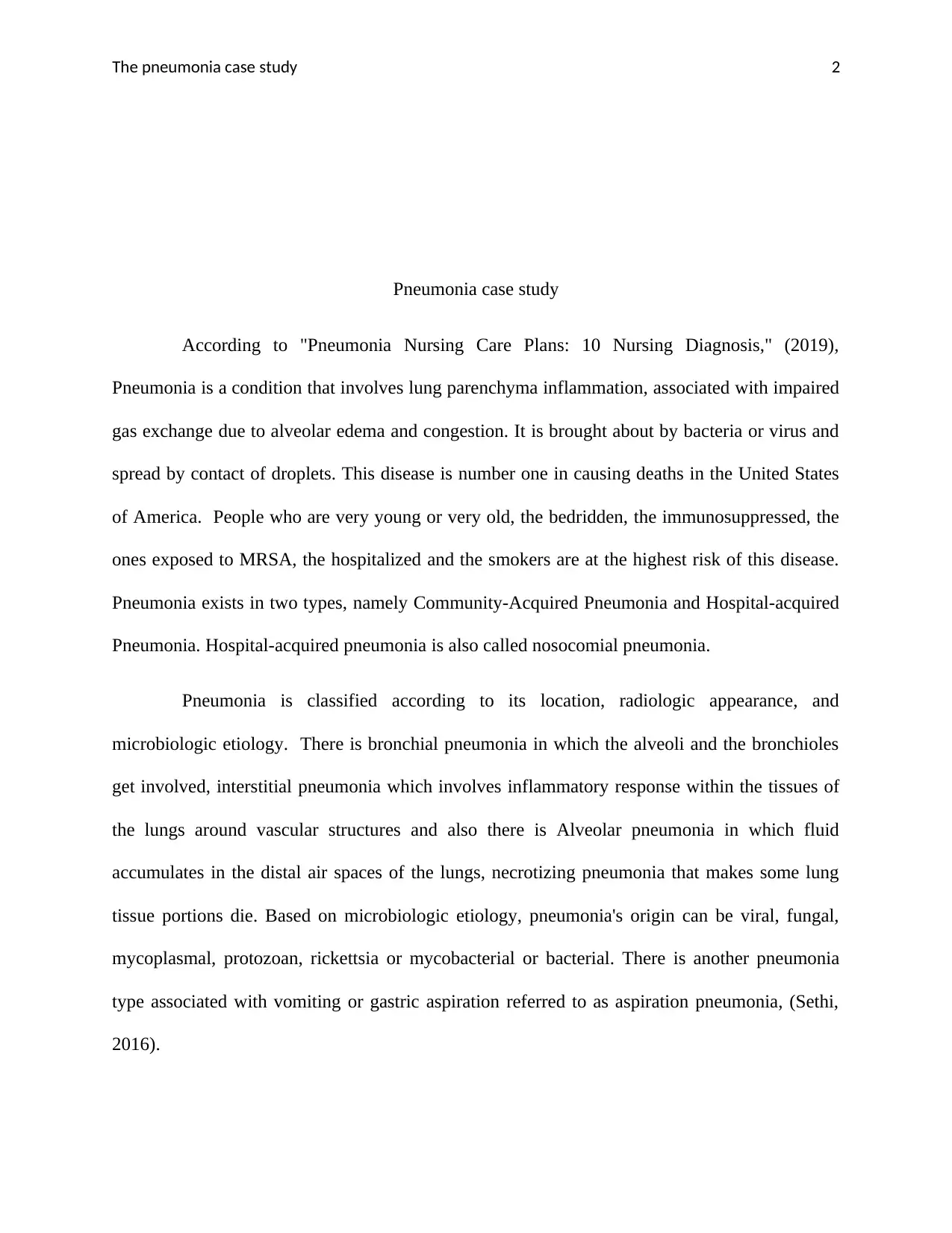
The pneumonia case study 2
Pneumonia case study
According to "Pneumonia Nursing Care Plans: 10 Nursing Diagnosis," (2019),
Pneumonia is a condition that involves lung parenchyma inflammation, associated with impaired
gas exchange due to alveolar edema and congestion. It is brought about by bacteria or virus and
spread by contact of droplets. This disease is number one in causing deaths in the United States
of America. People who are very young or very old, the bedridden, the immunosuppressed, the
ones exposed to MRSA, the hospitalized and the smokers are at the highest risk of this disease.
Pneumonia exists in two types, namely Community-Acquired Pneumonia and Hospital-acquired
Pneumonia. Hospital-acquired pneumonia is also called nosocomial pneumonia.
Pneumonia is classified according to its location, radiologic appearance, and
microbiologic etiology. There is bronchial pneumonia in which the alveoli and the bronchioles
get involved, interstitial pneumonia which involves inflammatory response within the tissues of
the lungs around vascular structures and also there is Alveolar pneumonia in which fluid
accumulates in the distal air spaces of the lungs, necrotizing pneumonia that makes some lung
tissue portions die. Based on microbiologic etiology, pneumonia's origin can be viral, fungal,
mycoplasmal, protozoan, rickettsia or mycobacterial or bacterial. There is another pneumonia
type associated with vomiting or gastric aspiration referred to as aspiration pneumonia, (Sethi,
2016).
Pneumonia case study
According to "Pneumonia Nursing Care Plans: 10 Nursing Diagnosis," (2019),
Pneumonia is a condition that involves lung parenchyma inflammation, associated with impaired
gas exchange due to alveolar edema and congestion. It is brought about by bacteria or virus and
spread by contact of droplets. This disease is number one in causing deaths in the United States
of America. People who are very young or very old, the bedridden, the immunosuppressed, the
ones exposed to MRSA, the hospitalized and the smokers are at the highest risk of this disease.
Pneumonia exists in two types, namely Community-Acquired Pneumonia and Hospital-acquired
Pneumonia. Hospital-acquired pneumonia is also called nosocomial pneumonia.
Pneumonia is classified according to its location, radiologic appearance, and
microbiologic etiology. There is bronchial pneumonia in which the alveoli and the bronchioles
get involved, interstitial pneumonia which involves inflammatory response within the tissues of
the lungs around vascular structures and also there is Alveolar pneumonia in which fluid
accumulates in the distal air spaces of the lungs, necrotizing pneumonia that makes some lung
tissue portions die. Based on microbiologic etiology, pneumonia's origin can be viral, fungal,
mycoplasmal, protozoan, rickettsia or mycobacterial or bacterial. There is another pneumonia
type associated with vomiting or gastric aspiration referred to as aspiration pneumonia, (Sethi,
2016).
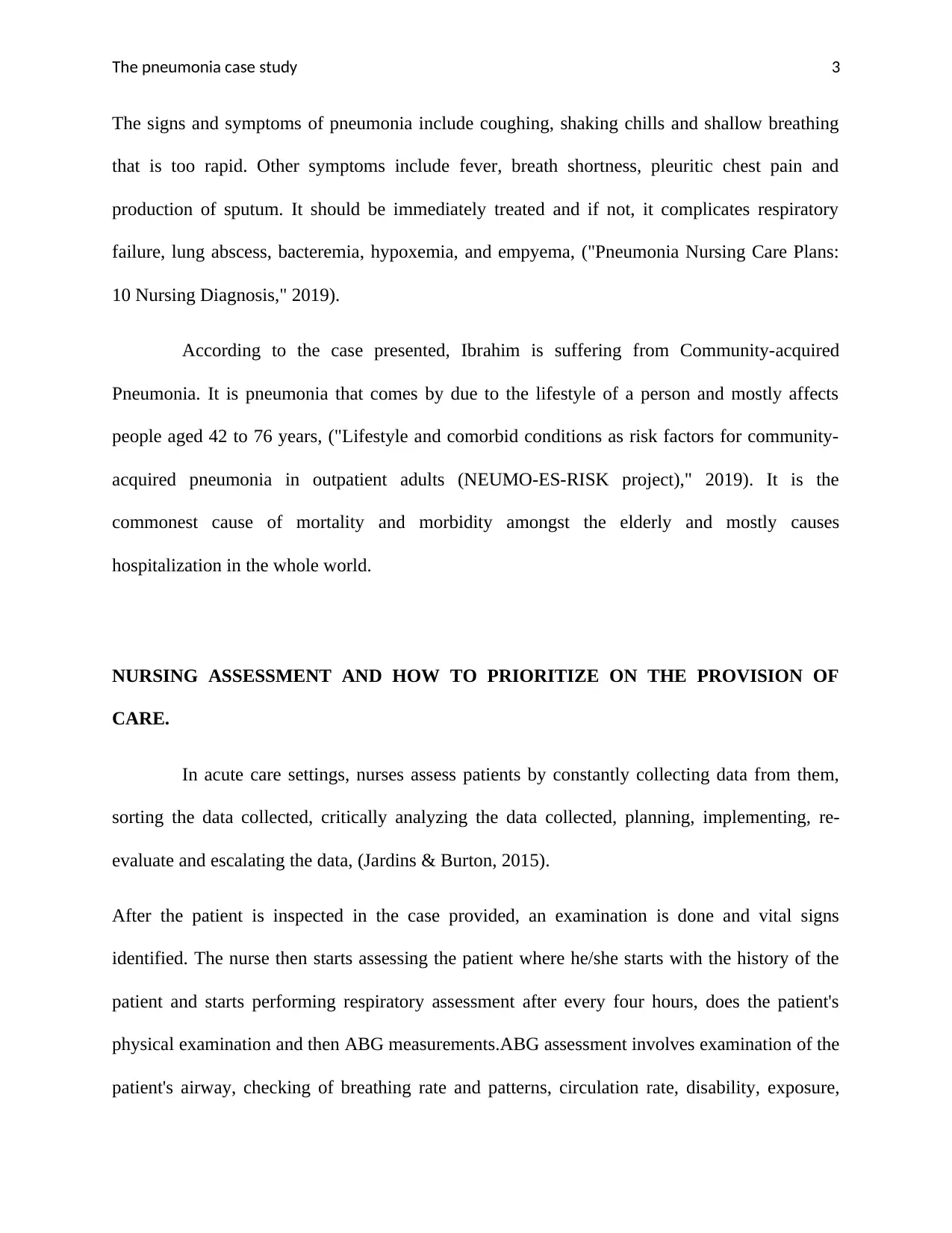
The pneumonia case study 3
The signs and symptoms of pneumonia include coughing, shaking chills and shallow breathing
that is too rapid. Other symptoms include fever, breath shortness, pleuritic chest pain and
production of sputum. It should be immediately treated and if not, it complicates respiratory
failure, lung abscess, bacteremia, hypoxemia, and empyema, ("Pneumonia Nursing Care Plans:
10 Nursing Diagnosis," 2019).
According to the case presented, Ibrahim is suffering from Community-acquired
Pneumonia. It is pneumonia that comes by due to the lifestyle of a person and mostly affects
people aged 42 to 76 years, ("Lifestyle and comorbid conditions as risk factors for community-
acquired pneumonia in outpatient adults (NEUMO-ES-RISK project)," 2019). It is the
commonest cause of mortality and morbidity amongst the elderly and mostly causes
hospitalization in the whole world.
NURSING ASSESSMENT AND HOW TO PRIORITIZE ON THE PROVISION OF
CARE.
In acute care settings, nurses assess patients by constantly collecting data from them,
sorting the data collected, critically analyzing the data collected, planning, implementing, re-
evaluate and escalating the data, (Jardins & Burton, 2015).
After the patient is inspected in the case provided, an examination is done and vital signs
identified. The nurse then starts assessing the patient where he/she starts with the history of the
patient and starts performing respiratory assessment after every four hours, does the patient's
physical examination and then ABG measurements.ABG assessment involves examination of the
patient's airway, checking of breathing rate and patterns, circulation rate, disability, exposure,
The signs and symptoms of pneumonia include coughing, shaking chills and shallow breathing
that is too rapid. Other symptoms include fever, breath shortness, pleuritic chest pain and
production of sputum. It should be immediately treated and if not, it complicates respiratory
failure, lung abscess, bacteremia, hypoxemia, and empyema, ("Pneumonia Nursing Care Plans:
10 Nursing Diagnosis," 2019).
According to the case presented, Ibrahim is suffering from Community-acquired
Pneumonia. It is pneumonia that comes by due to the lifestyle of a person and mostly affects
people aged 42 to 76 years, ("Lifestyle and comorbid conditions as risk factors for community-
acquired pneumonia in outpatient adults (NEUMO-ES-RISK project)," 2019). It is the
commonest cause of mortality and morbidity amongst the elderly and mostly causes
hospitalization in the whole world.
NURSING ASSESSMENT AND HOW TO PRIORITIZE ON THE PROVISION OF
CARE.
In acute care settings, nurses assess patients by constantly collecting data from them,
sorting the data collected, critically analyzing the data collected, planning, implementing, re-
evaluate and escalating the data, (Jardins & Burton, 2015).
After the patient is inspected in the case provided, an examination is done and vital signs
identified. The nurse then starts assessing the patient where he/she starts with the history of the
patient and starts performing respiratory assessment after every four hours, does the patient's
physical examination and then ABG measurements.ABG assessment involves examination of the
patient's airway, checking of breathing rate and patterns, circulation rate, disability, exposure,
⊘ This is a preview!⊘
Do you want full access?
Subscribe today to unlock all pages.

Trusted by 1+ million students worldwide
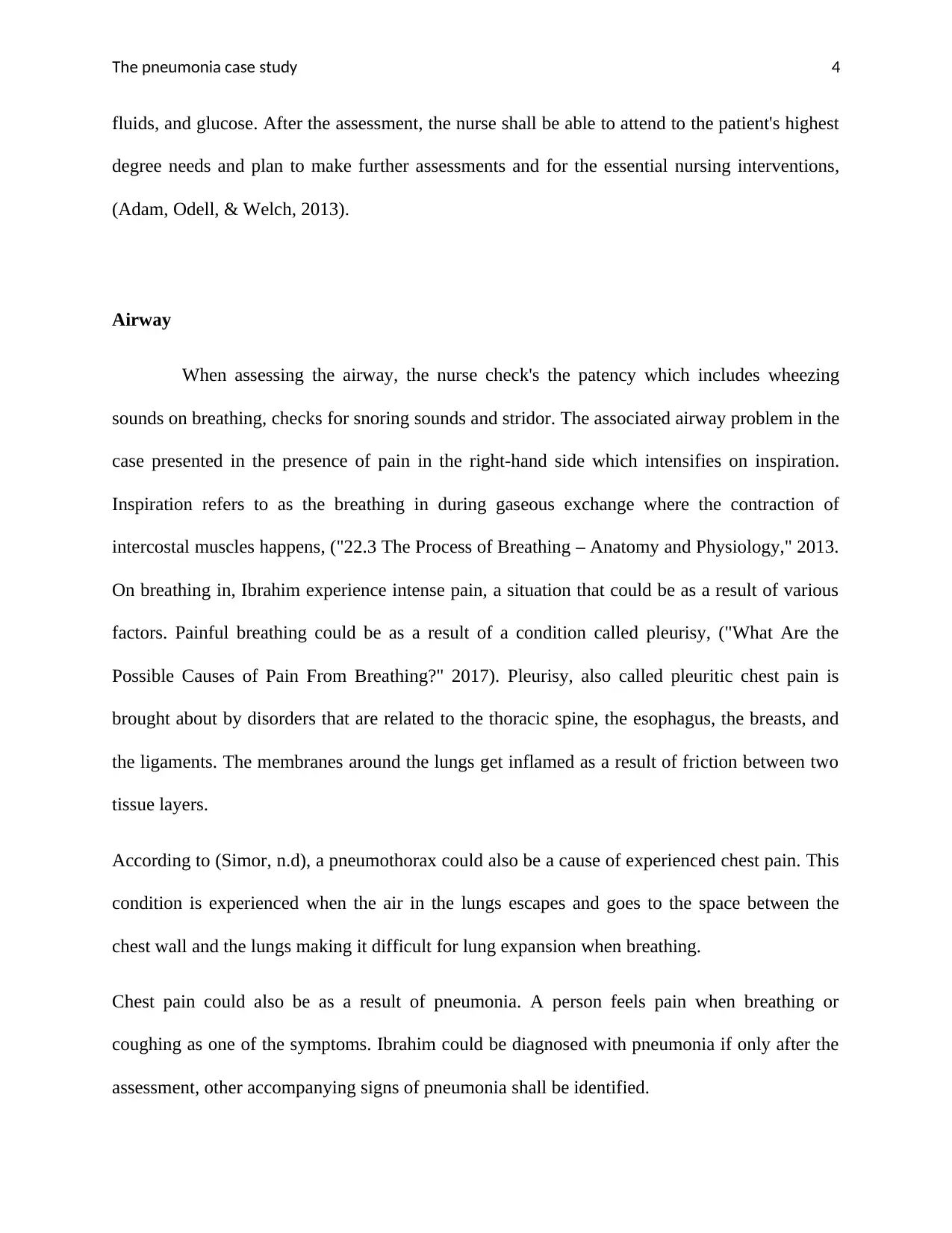
The pneumonia case study 4
fluids, and glucose. After the assessment, the nurse shall be able to attend to the patient's highest
degree needs and plan to make further assessments and for the essential nursing interventions,
(Adam, Odell, & Welch, 2013).
Airway
When assessing the airway, the nurse check's the patency which includes wheezing
sounds on breathing, checks for snoring sounds and stridor. The associated airway problem in the
case presented in the presence of pain in the right-hand side which intensifies on inspiration.
Inspiration refers to as the breathing in during gaseous exchange where the contraction of
intercostal muscles happens, ("22.3 The Process of Breathing – Anatomy and Physiology," 2013.
On breathing in, Ibrahim experience intense pain, a situation that could be as a result of various
factors. Painful breathing could be as a result of a condition called pleurisy, ("What Are the
Possible Causes of Pain From Breathing?" 2017). Pleurisy, also called pleuritic chest pain is
brought about by disorders that are related to the thoracic spine, the esophagus, the breasts, and
the ligaments. The membranes around the lungs get inflamed as a result of friction between two
tissue layers.
According to (Simor, n.d), a pneumothorax could also be a cause of experienced chest pain. This
condition is experienced when the air in the lungs escapes and goes to the space between the
chest wall and the lungs making it difficult for lung expansion when breathing.
Chest pain could also be as a result of pneumonia. A person feels pain when breathing or
coughing as one of the symptoms. Ibrahim could be diagnosed with pneumonia if only after the
assessment, other accompanying signs of pneumonia shall be identified.
fluids, and glucose. After the assessment, the nurse shall be able to attend to the patient's highest
degree needs and plan to make further assessments and for the essential nursing interventions,
(Adam, Odell, & Welch, 2013).
Airway
When assessing the airway, the nurse check's the patency which includes wheezing
sounds on breathing, checks for snoring sounds and stridor. The associated airway problem in the
case presented in the presence of pain in the right-hand side which intensifies on inspiration.
Inspiration refers to as the breathing in during gaseous exchange where the contraction of
intercostal muscles happens, ("22.3 The Process of Breathing – Anatomy and Physiology," 2013.
On breathing in, Ibrahim experience intense pain, a situation that could be as a result of various
factors. Painful breathing could be as a result of a condition called pleurisy, ("What Are the
Possible Causes of Pain From Breathing?" 2017). Pleurisy, also called pleuritic chest pain is
brought about by disorders that are related to the thoracic spine, the esophagus, the breasts, and
the ligaments. The membranes around the lungs get inflamed as a result of friction between two
tissue layers.
According to (Simor, n.d), a pneumothorax could also be a cause of experienced chest pain. This
condition is experienced when the air in the lungs escapes and goes to the space between the
chest wall and the lungs making it difficult for lung expansion when breathing.
Chest pain could also be as a result of pneumonia. A person feels pain when breathing or
coughing as one of the symptoms. Ibrahim could be diagnosed with pneumonia if only after the
assessment, other accompanying signs of pneumonia shall be identified.
Paraphrase This Document
Need a fresh take? Get an instant paraphrase of this document with our AI Paraphraser
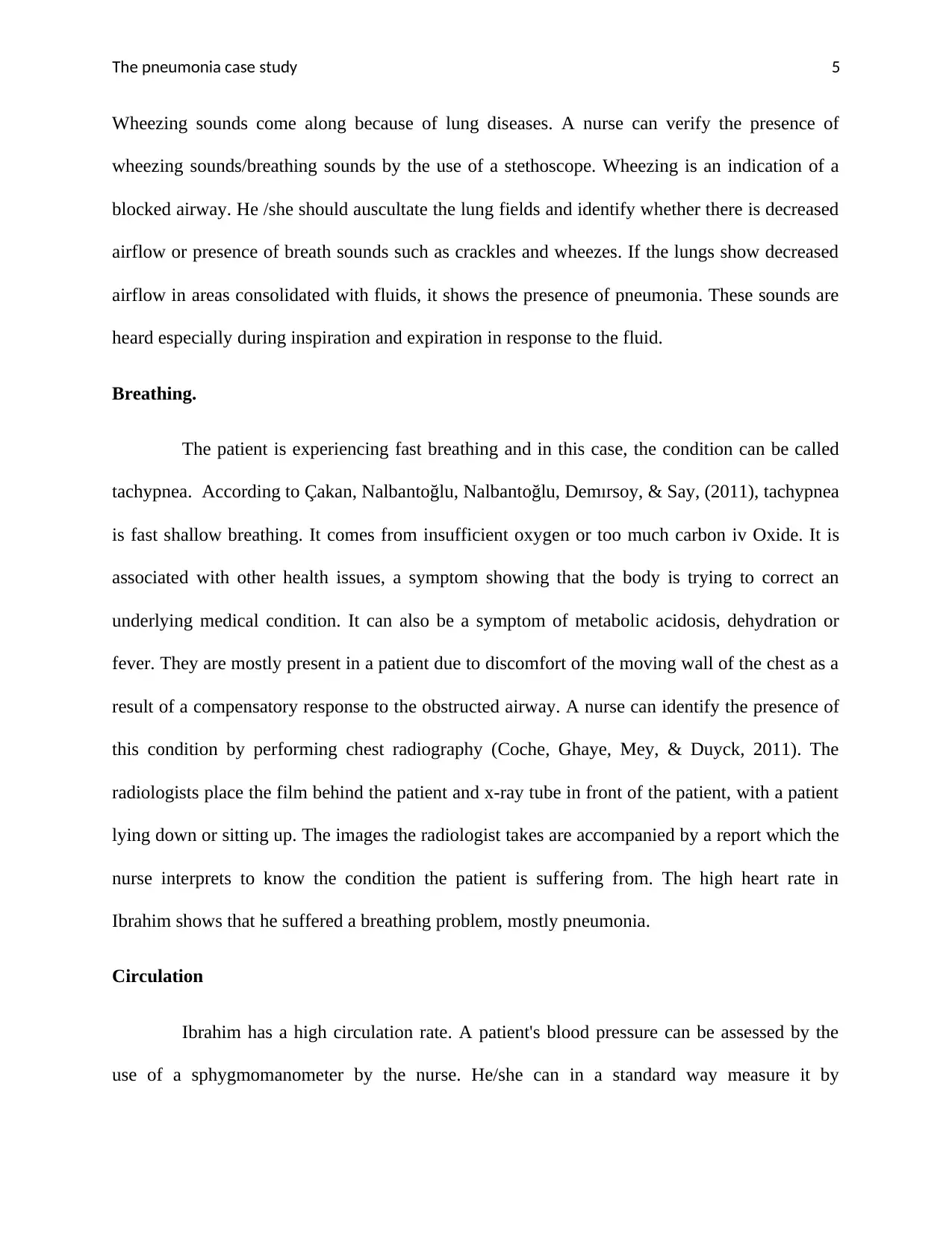
The pneumonia case study 5
Wheezing sounds come along because of lung diseases. A nurse can verify the presence of
wheezing sounds/breathing sounds by the use of a stethoscope. Wheezing is an indication of a
blocked airway. He /she should auscultate the lung fields and identify whether there is decreased
airflow or presence of breath sounds such as crackles and wheezes. If the lungs show decreased
airflow in areas consolidated with fluids, it shows the presence of pneumonia. These sounds are
heard especially during inspiration and expiration in response to the fluid.
Breathing.
The patient is experiencing fast breathing and in this case, the condition can be called
tachypnea. According to Çakan, Nalbantoğlu, Nalbantoğlu, Demırsoy, & Say, (2011), tachypnea
is fast shallow breathing. It comes from insufficient oxygen or too much carbon iv Oxide. It is
associated with other health issues, a symptom showing that the body is trying to correct an
underlying medical condition. It can also be a symptom of metabolic acidosis, dehydration or
fever. They are mostly present in a patient due to discomfort of the moving wall of the chest as a
result of a compensatory response to the obstructed airway. A nurse can identify the presence of
this condition by performing chest radiography (Coche, Ghaye, Mey, & Duyck, 2011). The
radiologists place the film behind the patient and x-ray tube in front of the patient, with a patient
lying down or sitting up. The images the radiologist takes are accompanied by a report which the
nurse interprets to know the condition the patient is suffering from. The high heart rate in
Ibrahim shows that he suffered a breathing problem, mostly pneumonia.
Circulation
Ibrahim has a high circulation rate. A patient's blood pressure can be assessed by the
use of a sphygmomanometer by the nurse. He/she can in a standard way measure it by
Wheezing sounds come along because of lung diseases. A nurse can verify the presence of
wheezing sounds/breathing sounds by the use of a stethoscope. Wheezing is an indication of a
blocked airway. He /she should auscultate the lung fields and identify whether there is decreased
airflow or presence of breath sounds such as crackles and wheezes. If the lungs show decreased
airflow in areas consolidated with fluids, it shows the presence of pneumonia. These sounds are
heard especially during inspiration and expiration in response to the fluid.
Breathing.
The patient is experiencing fast breathing and in this case, the condition can be called
tachypnea. According to Çakan, Nalbantoğlu, Nalbantoğlu, Demırsoy, & Say, (2011), tachypnea
is fast shallow breathing. It comes from insufficient oxygen or too much carbon iv Oxide. It is
associated with other health issues, a symptom showing that the body is trying to correct an
underlying medical condition. It can also be a symptom of metabolic acidosis, dehydration or
fever. They are mostly present in a patient due to discomfort of the moving wall of the chest as a
result of a compensatory response to the obstructed airway. A nurse can identify the presence of
this condition by performing chest radiography (Coche, Ghaye, Mey, & Duyck, 2011). The
radiologists place the film behind the patient and x-ray tube in front of the patient, with a patient
lying down or sitting up. The images the radiologist takes are accompanied by a report which the
nurse interprets to know the condition the patient is suffering from. The high heart rate in
Ibrahim shows that he suffered a breathing problem, mostly pneumonia.
Circulation
Ibrahim has a high circulation rate. A patient's blood pressure can be assessed by the
use of a sphygmomanometer by the nurse. He/she can in a standard way measure it by
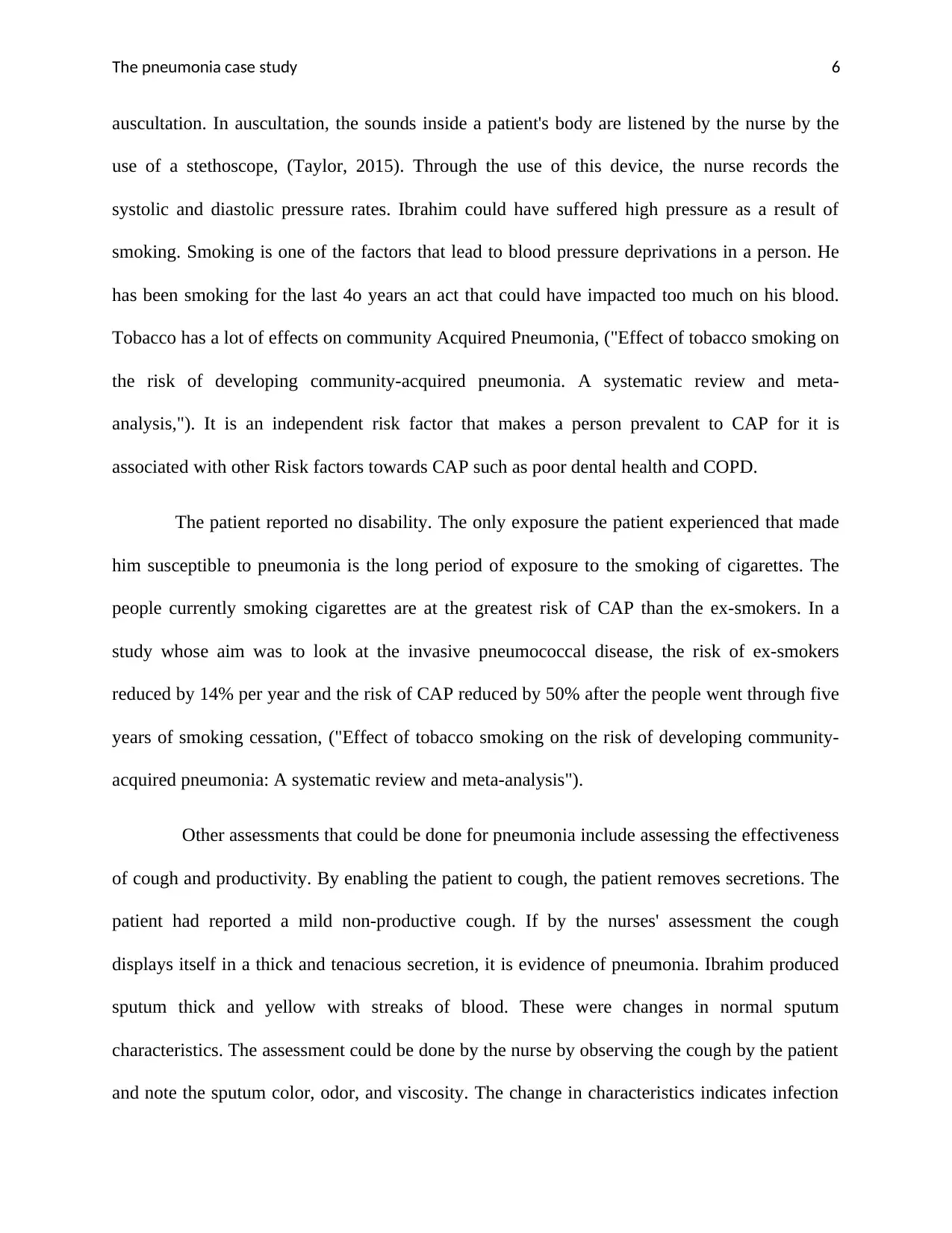
The pneumonia case study 6
auscultation. In auscultation, the sounds inside a patient's body are listened by the nurse by the
use of a stethoscope, (Taylor, 2015). Through the use of this device, the nurse records the
systolic and diastolic pressure rates. Ibrahim could have suffered high pressure as a result of
smoking. Smoking is one of the factors that lead to blood pressure deprivations in a person. He
has been smoking for the last 4o years an act that could have impacted too much on his blood.
Tobacco has a lot of effects on community Acquired Pneumonia, ("Effect of tobacco smoking on
the risk of developing community-acquired pneumonia. A systematic review and meta-
analysis,"). It is an independent risk factor that makes a person prevalent to CAP for it is
associated with other Risk factors towards CAP such as poor dental health and COPD.
The patient reported no disability. The only exposure the patient experienced that made
him susceptible to pneumonia is the long period of exposure to the smoking of cigarettes. The
people currently smoking cigarettes are at the greatest risk of CAP than the ex-smokers. In a
study whose aim was to look at the invasive pneumococcal disease, the risk of ex-smokers
reduced by 14% per year and the risk of CAP reduced by 50% after the people went through five
years of smoking cessation, ("Effect of tobacco smoking on the risk of developing community-
acquired pneumonia: A systematic review and meta-analysis").
Other assessments that could be done for pneumonia include assessing the effectiveness
of cough and productivity. By enabling the patient to cough, the patient removes secretions. The
patient had reported a mild non-productive cough. If by the nurses' assessment the cough
displays itself in a thick and tenacious secretion, it is evidence of pneumonia. Ibrahim produced
sputum thick and yellow with streaks of blood. These were changes in normal sputum
characteristics. The assessment could be done by the nurse by observing the cough by the patient
and note the sputum color, odor, and viscosity. The change in characteristics indicates infection
auscultation. In auscultation, the sounds inside a patient's body are listened by the nurse by the
use of a stethoscope, (Taylor, 2015). Through the use of this device, the nurse records the
systolic and diastolic pressure rates. Ibrahim could have suffered high pressure as a result of
smoking. Smoking is one of the factors that lead to blood pressure deprivations in a person. He
has been smoking for the last 4o years an act that could have impacted too much on his blood.
Tobacco has a lot of effects on community Acquired Pneumonia, ("Effect of tobacco smoking on
the risk of developing community-acquired pneumonia. A systematic review and meta-
analysis,"). It is an independent risk factor that makes a person prevalent to CAP for it is
associated with other Risk factors towards CAP such as poor dental health and COPD.
The patient reported no disability. The only exposure the patient experienced that made
him susceptible to pneumonia is the long period of exposure to the smoking of cigarettes. The
people currently smoking cigarettes are at the greatest risk of CAP than the ex-smokers. In a
study whose aim was to look at the invasive pneumococcal disease, the risk of ex-smokers
reduced by 14% per year and the risk of CAP reduced by 50% after the people went through five
years of smoking cessation, ("Effect of tobacco smoking on the risk of developing community-
acquired pneumonia: A systematic review and meta-analysis").
Other assessments that could be done for pneumonia include assessing the effectiveness
of cough and productivity. By enabling the patient to cough, the patient removes secretions. The
patient had reported a mild non-productive cough. If by the nurses' assessment the cough
displays itself in a thick and tenacious secretion, it is evidence of pneumonia. Ibrahim produced
sputum thick and yellow with streaks of blood. These were changes in normal sputum
characteristics. The assessment could be done by the nurse by observing the cough by the patient
and note the sputum color, odor, and viscosity. The change in characteristics indicates infection
⊘ This is a preview!⊘
Do you want full access?
Subscribe today to unlock all pages.

Trusted by 1+ million students worldwide
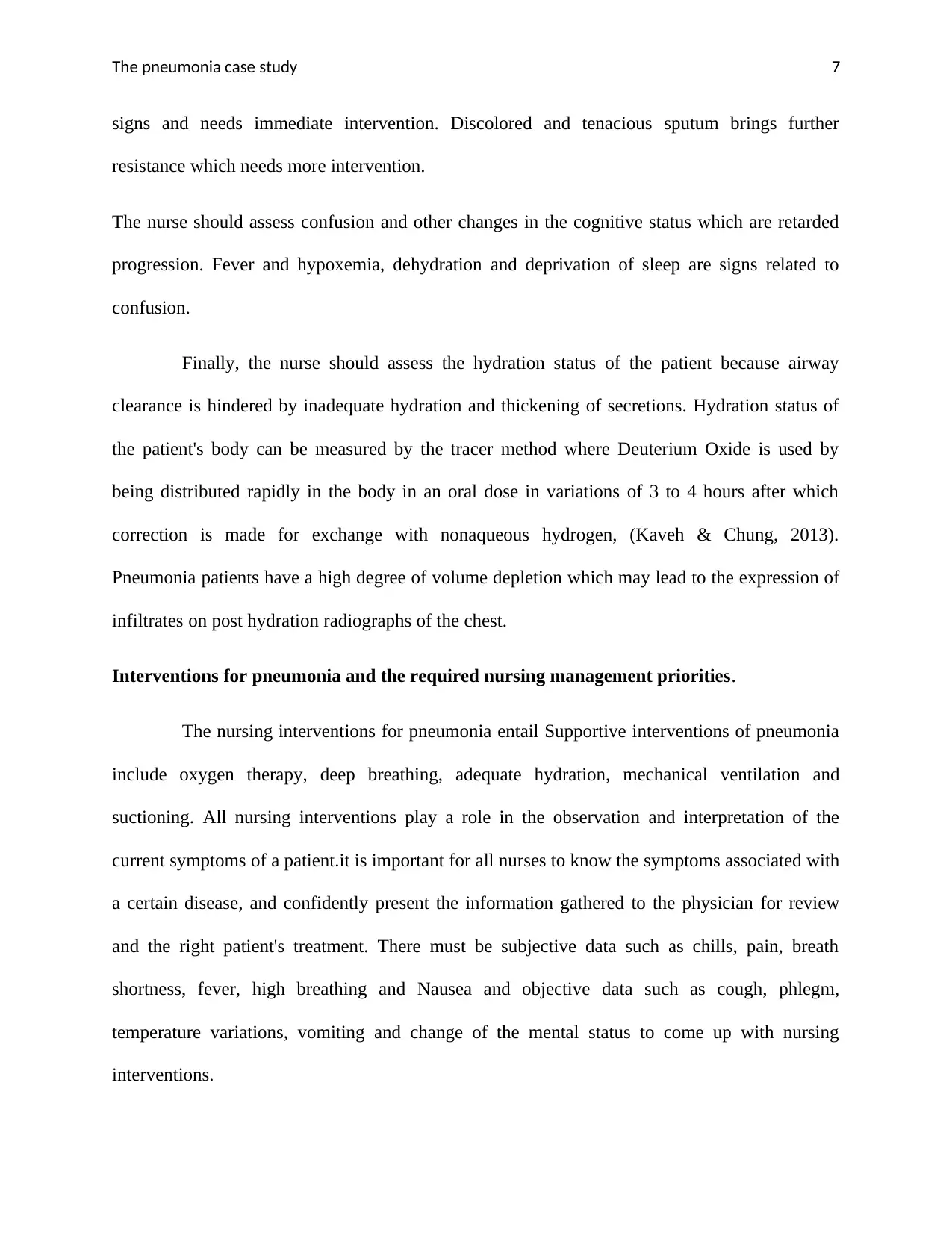
The pneumonia case study 7
signs and needs immediate intervention. Discolored and tenacious sputum brings further
resistance which needs more intervention.
The nurse should assess confusion and other changes in the cognitive status which are retarded
progression. Fever and hypoxemia, dehydration and deprivation of sleep are signs related to
confusion.
Finally, the nurse should assess the hydration status of the patient because airway
clearance is hindered by inadequate hydration and thickening of secretions. Hydration status of
the patient's body can be measured by the tracer method where Deuterium Oxide is used by
being distributed rapidly in the body in an oral dose in variations of 3 to 4 hours after which
correction is made for exchange with nonaqueous hydrogen, (Kaveh & Chung, 2013).
Pneumonia patients have a high degree of volume depletion which may lead to the expression of
infiltrates on post hydration radiographs of the chest.
Interventions for pneumonia and the required nursing management priorities.
The nursing interventions for pneumonia entail Supportive interventions of pneumonia
include oxygen therapy, deep breathing, adequate hydration, mechanical ventilation and
suctioning. All nursing interventions play a role in the observation and interpretation of the
current symptoms of a patient.it is important for all nurses to know the symptoms associated with
a certain disease, and confidently present the information gathered to the physician for review
and the right patient's treatment. There must be subjective data such as chills, pain, breath
shortness, fever, high breathing and Nausea and objective data such as cough, phlegm,
temperature variations, vomiting and change of the mental status to come up with nursing
interventions.
signs and needs immediate intervention. Discolored and tenacious sputum brings further
resistance which needs more intervention.
The nurse should assess confusion and other changes in the cognitive status which are retarded
progression. Fever and hypoxemia, dehydration and deprivation of sleep are signs related to
confusion.
Finally, the nurse should assess the hydration status of the patient because airway
clearance is hindered by inadequate hydration and thickening of secretions. Hydration status of
the patient's body can be measured by the tracer method where Deuterium Oxide is used by
being distributed rapidly in the body in an oral dose in variations of 3 to 4 hours after which
correction is made for exchange with nonaqueous hydrogen, (Kaveh & Chung, 2013).
Pneumonia patients have a high degree of volume depletion which may lead to the expression of
infiltrates on post hydration radiographs of the chest.
Interventions for pneumonia and the required nursing management priorities.
The nursing interventions for pneumonia entail Supportive interventions of pneumonia
include oxygen therapy, deep breathing, adequate hydration, mechanical ventilation and
suctioning. All nursing interventions play a role in the observation and interpretation of the
current symptoms of a patient.it is important for all nurses to know the symptoms associated with
a certain disease, and confidently present the information gathered to the physician for review
and the right patient's treatment. There must be subjective data such as chills, pain, breath
shortness, fever, high breathing and Nausea and objective data such as cough, phlegm,
temperature variations, vomiting and change of the mental status to come up with nursing
interventions.
Paraphrase This Document
Need a fresh take? Get an instant paraphrase of this document with our AI Paraphraser
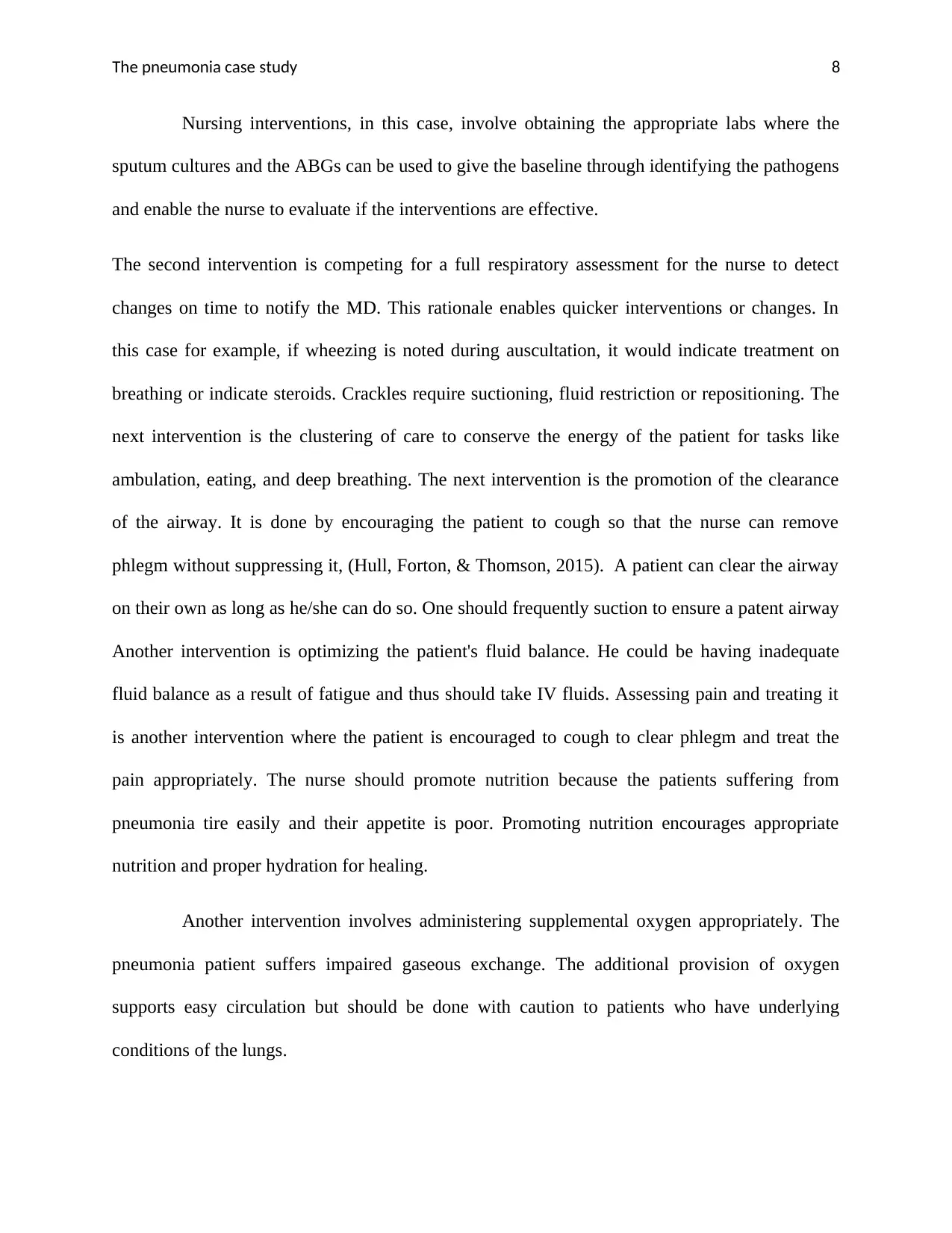
The pneumonia case study 8
Nursing interventions, in this case, involve obtaining the appropriate labs where the
sputum cultures and the ABGs can be used to give the baseline through identifying the pathogens
and enable the nurse to evaluate if the interventions are effective.
The second intervention is competing for a full respiratory assessment for the nurse to detect
changes on time to notify the MD. This rationale enables quicker interventions or changes. In
this case for example, if wheezing is noted during auscultation, it would indicate treatment on
breathing or indicate steroids. Crackles require suctioning, fluid restriction or repositioning. The
next intervention is the clustering of care to conserve the energy of the patient for tasks like
ambulation, eating, and deep breathing. The next intervention is the promotion of the clearance
of the airway. It is done by encouraging the patient to cough so that the nurse can remove
phlegm without suppressing it, (Hull, Forton, & Thomson, 2015). A patient can clear the airway
on their own as long as he/she can do so. One should frequently suction to ensure a patent airway
Another intervention is optimizing the patient's fluid balance. He could be having inadequate
fluid balance as a result of fatigue and thus should take IV fluids. Assessing pain and treating it
is another intervention where the patient is encouraged to cough to clear phlegm and treat the
pain appropriately. The nurse should promote nutrition because the patients suffering from
pneumonia tire easily and their appetite is poor. Promoting nutrition encourages appropriate
nutrition and proper hydration for healing.
Another intervention involves administering supplemental oxygen appropriately. The
pneumonia patient suffers impaired gaseous exchange. The additional provision of oxygen
supports easy circulation but should be done with caution to patients who have underlying
conditions of the lungs.
Nursing interventions, in this case, involve obtaining the appropriate labs where the
sputum cultures and the ABGs can be used to give the baseline through identifying the pathogens
and enable the nurse to evaluate if the interventions are effective.
The second intervention is competing for a full respiratory assessment for the nurse to detect
changes on time to notify the MD. This rationale enables quicker interventions or changes. In
this case for example, if wheezing is noted during auscultation, it would indicate treatment on
breathing or indicate steroids. Crackles require suctioning, fluid restriction or repositioning. The
next intervention is the clustering of care to conserve the energy of the patient for tasks like
ambulation, eating, and deep breathing. The next intervention is the promotion of the clearance
of the airway. It is done by encouraging the patient to cough so that the nurse can remove
phlegm without suppressing it, (Hull, Forton, & Thomson, 2015). A patient can clear the airway
on their own as long as he/she can do so. One should frequently suction to ensure a patent airway
Another intervention is optimizing the patient's fluid balance. He could be having inadequate
fluid balance as a result of fatigue and thus should take IV fluids. Assessing pain and treating it
is another intervention where the patient is encouraged to cough to clear phlegm and treat the
pain appropriately. The nurse should promote nutrition because the patients suffering from
pneumonia tire easily and their appetite is poor. Promoting nutrition encourages appropriate
nutrition and proper hydration for healing.
Another intervention involves administering supplemental oxygen appropriately. The
pneumonia patient suffers impaired gaseous exchange. The additional provision of oxygen
supports easy circulation but should be done with caution to patients who have underlying
conditions of the lungs.
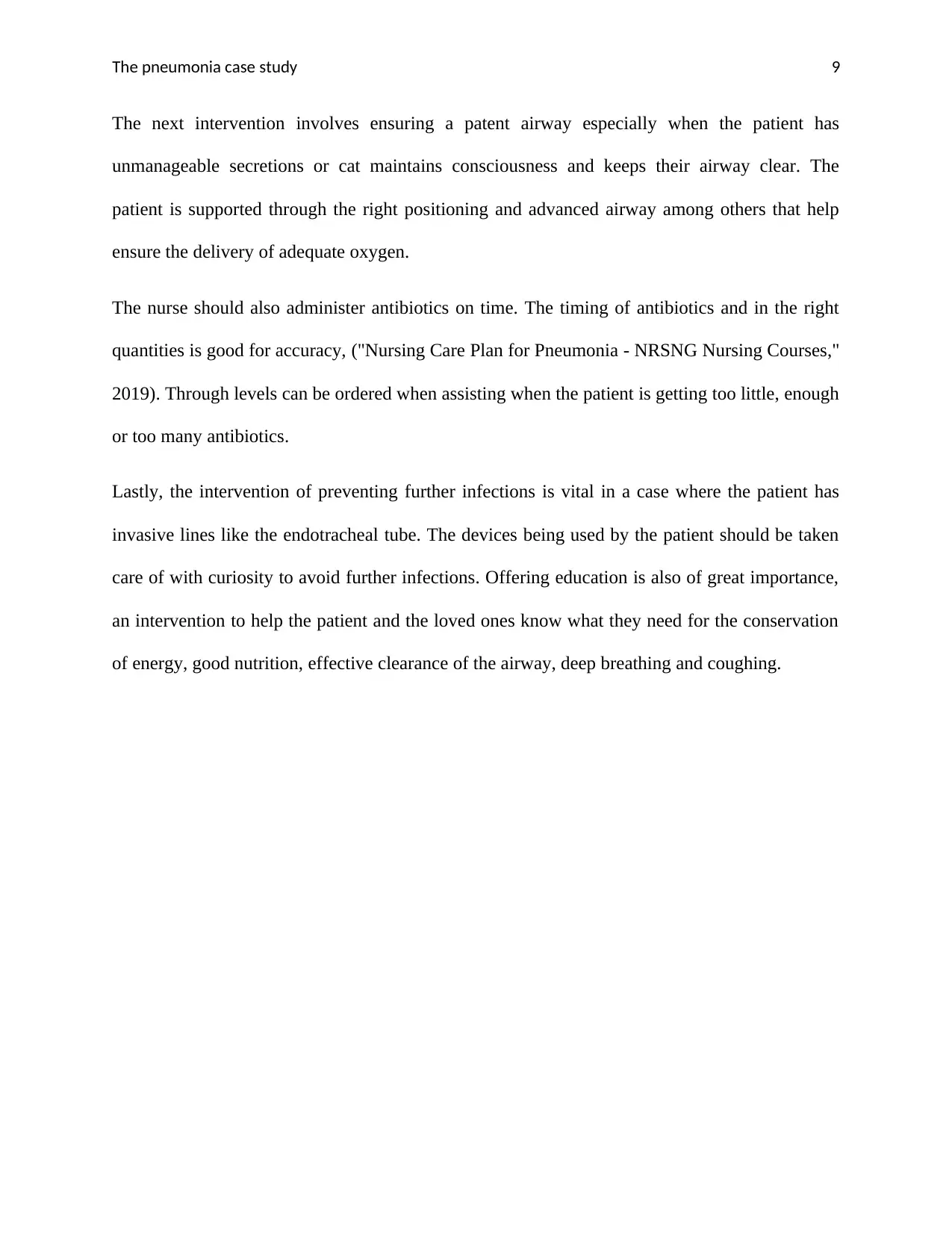
The pneumonia case study 9
The next intervention involves ensuring a patent airway especially when the patient has
unmanageable secretions or cat maintains consciousness and keeps their airway clear. The
patient is supported through the right positioning and advanced airway among others that help
ensure the delivery of adequate oxygen.
The nurse should also administer antibiotics on time. The timing of antibiotics and in the right
quantities is good for accuracy, ("Nursing Care Plan for Pneumonia - NRSNG Nursing Courses,"
2019). Through levels can be ordered when assisting when the patient is getting too little, enough
or too many antibiotics.
Lastly, the intervention of preventing further infections is vital in a case where the patient has
invasive lines like the endotracheal tube. The devices being used by the patient should be taken
care of with curiosity to avoid further infections. Offering education is also of great importance,
an intervention to help the patient and the loved ones know what they need for the conservation
of energy, good nutrition, effective clearance of the airway, deep breathing and coughing.
The next intervention involves ensuring a patent airway especially when the patient has
unmanageable secretions or cat maintains consciousness and keeps their airway clear. The
patient is supported through the right positioning and advanced airway among others that help
ensure the delivery of adequate oxygen.
The nurse should also administer antibiotics on time. The timing of antibiotics and in the right
quantities is good for accuracy, ("Nursing Care Plan for Pneumonia - NRSNG Nursing Courses,"
2019). Through levels can be ordered when assisting when the patient is getting too little, enough
or too many antibiotics.
Lastly, the intervention of preventing further infections is vital in a case where the patient has
invasive lines like the endotracheal tube. The devices being used by the patient should be taken
care of with curiosity to avoid further infections. Offering education is also of great importance,
an intervention to help the patient and the loved ones know what they need for the conservation
of energy, good nutrition, effective clearance of the airway, deep breathing and coughing.
⊘ This is a preview!⊘
Do you want full access?
Subscribe today to unlock all pages.

Trusted by 1+ million students worldwide
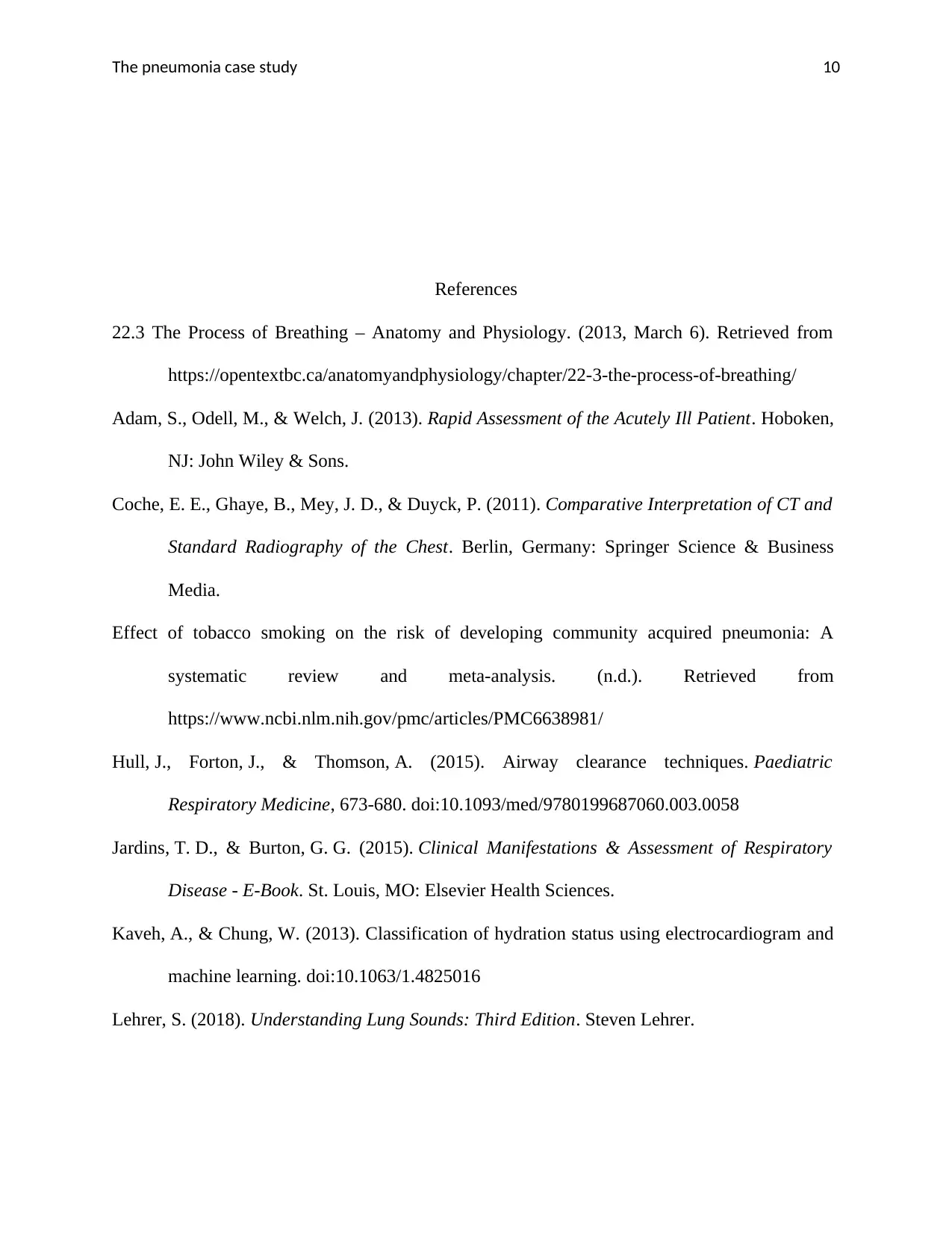
The pneumonia case study 10
References
22.3 The Process of Breathing – Anatomy and Physiology. (2013, March 6). Retrieved from
https://opentextbc.ca/anatomyandphysiology/chapter/22-3-the-process-of-breathing/
Adam, S., Odell, M., & Welch, J. (2013). Rapid Assessment of the Acutely Ill Patient. Hoboken,
NJ: John Wiley & Sons.
Coche, E. E., Ghaye, B., Mey, J. D., & Duyck, P. (2011). Comparative Interpretation of CT and
Standard Radiography of the Chest. Berlin, Germany: Springer Science & Business
Media.
Effect of tobacco smoking on the risk of developing community acquired pneumonia: A
systematic review and meta-analysis. (n.d.). Retrieved from
https://www.ncbi.nlm.nih.gov/pmc/articles/PMC6638981/
Hull, J., Forton, J., & Thomson, A. (2015). Airway clearance techniques. Paediatric
Respiratory Medicine, 673-680. doi:10.1093/med/9780199687060.003.0058
Jardins, T. D., & Burton, G. G. (2015). Clinical Manifestations & Assessment of Respiratory
Disease - E-Book. St. Louis, MO: Elsevier Health Sciences.
Kaveh, A., & Chung, W. (2013). Classification of hydration status using electrocardiogram and
machine learning. doi:10.1063/1.4825016
Lehrer, S. (2018). Understanding Lung Sounds: Third Edition. Steven Lehrer.
References
22.3 The Process of Breathing – Anatomy and Physiology. (2013, March 6). Retrieved from
https://opentextbc.ca/anatomyandphysiology/chapter/22-3-the-process-of-breathing/
Adam, S., Odell, M., & Welch, J. (2013). Rapid Assessment of the Acutely Ill Patient. Hoboken,
NJ: John Wiley & Sons.
Coche, E. E., Ghaye, B., Mey, J. D., & Duyck, P. (2011). Comparative Interpretation of CT and
Standard Radiography of the Chest. Berlin, Germany: Springer Science & Business
Media.
Effect of tobacco smoking on the risk of developing community acquired pneumonia: A
systematic review and meta-analysis. (n.d.). Retrieved from
https://www.ncbi.nlm.nih.gov/pmc/articles/PMC6638981/
Hull, J., Forton, J., & Thomson, A. (2015). Airway clearance techniques. Paediatric
Respiratory Medicine, 673-680. doi:10.1093/med/9780199687060.003.0058
Jardins, T. D., & Burton, G. G. (2015). Clinical Manifestations & Assessment of Respiratory
Disease - E-Book. St. Louis, MO: Elsevier Health Sciences.
Kaveh, A., & Chung, W. (2013). Classification of hydration status using electrocardiogram and
machine learning. doi:10.1063/1.4825016
Lehrer, S. (2018). Understanding Lung Sounds: Third Edition. Steven Lehrer.
Paraphrase This Document
Need a fresh take? Get an instant paraphrase of this document with our AI Paraphraser
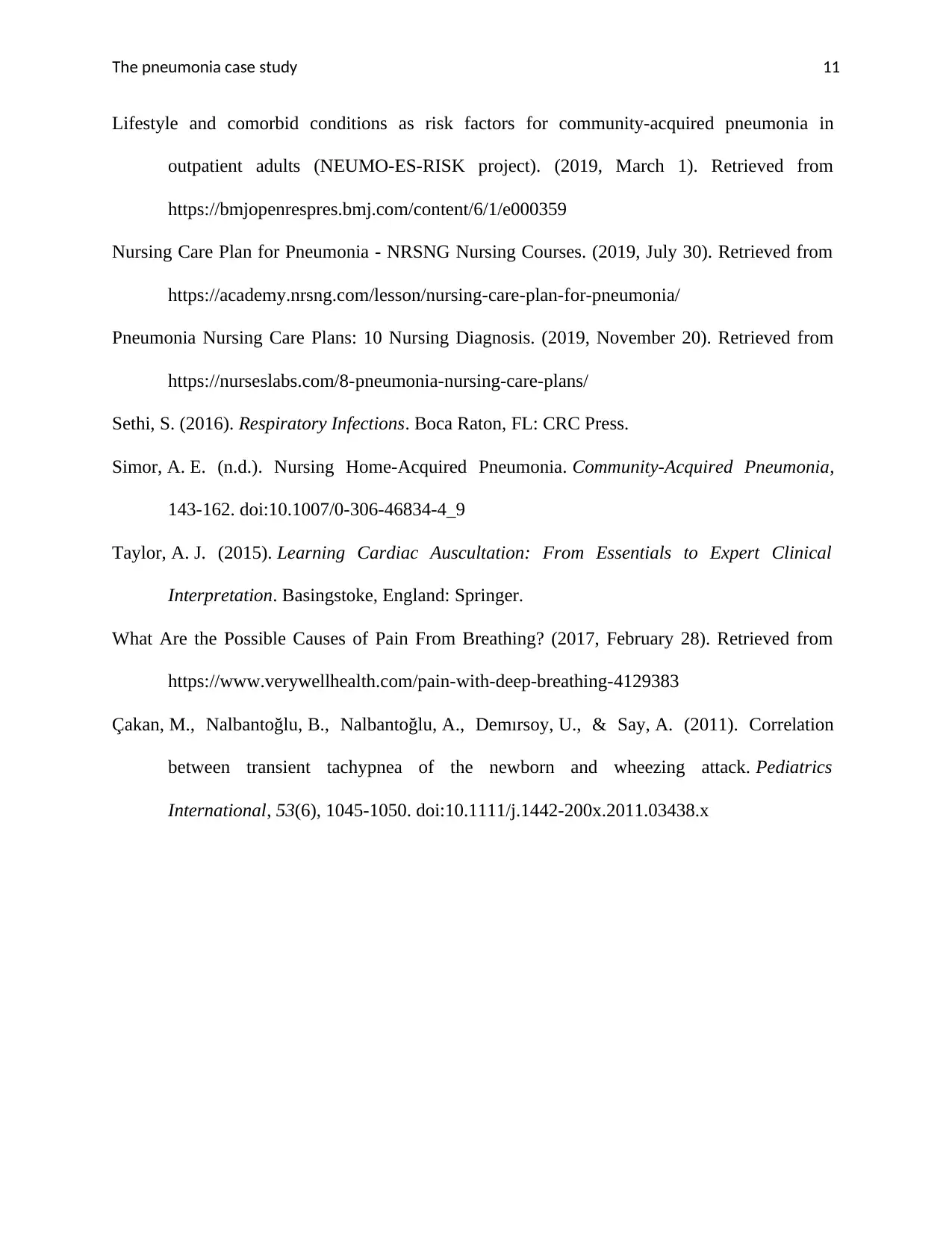
The pneumonia case study 11
Lifestyle and comorbid conditions as risk factors for community-acquired pneumonia in
outpatient adults (NEUMO-ES-RISK project). (2019, March 1). Retrieved from
https://bmjopenrespres.bmj.com/content/6/1/e000359
Nursing Care Plan for Pneumonia - NRSNG Nursing Courses. (2019, July 30). Retrieved from
https://academy.nrsng.com/lesson/nursing-care-plan-for-pneumonia/
Pneumonia Nursing Care Plans: 10 Nursing Diagnosis. (2019, November 20). Retrieved from
https://nurseslabs.com/8-pneumonia-nursing-care-plans/
Sethi, S. (2016). Respiratory Infections. Boca Raton, FL: CRC Press.
Simor, A. E. (n.d.). Nursing Home-Acquired Pneumonia. Community-Acquired Pneumonia,
143-162. doi:10.1007/0-306-46834-4_9
Taylor, A. J. (2015). Learning Cardiac Auscultation: From Essentials to Expert Clinical
Interpretation. Basingstoke, England: Springer.
What Are the Possible Causes of Pain From Breathing? (2017, February 28). Retrieved from
https://www.verywellhealth.com/pain-with-deep-breathing-4129383
Çakan, M., Nalbantoğlu, B., Nalbantoğlu, A., Demırsoy, U., & Say, A. (2011). Correlation
between transient tachypnea of the newborn and wheezing attack. Pediatrics
International, 53(6), 1045-1050. doi:10.1111/j.1442-200x.2011.03438.x
Lifestyle and comorbid conditions as risk factors for community-acquired pneumonia in
outpatient adults (NEUMO-ES-RISK project). (2019, March 1). Retrieved from
https://bmjopenrespres.bmj.com/content/6/1/e000359
Nursing Care Plan for Pneumonia - NRSNG Nursing Courses. (2019, July 30). Retrieved from
https://academy.nrsng.com/lesson/nursing-care-plan-for-pneumonia/
Pneumonia Nursing Care Plans: 10 Nursing Diagnosis. (2019, November 20). Retrieved from
https://nurseslabs.com/8-pneumonia-nursing-care-plans/
Sethi, S. (2016). Respiratory Infections. Boca Raton, FL: CRC Press.
Simor, A. E. (n.d.). Nursing Home-Acquired Pneumonia. Community-Acquired Pneumonia,
143-162. doi:10.1007/0-306-46834-4_9
Taylor, A. J. (2015). Learning Cardiac Auscultation: From Essentials to Expert Clinical
Interpretation. Basingstoke, England: Springer.
What Are the Possible Causes of Pain From Breathing? (2017, February 28). Retrieved from
https://www.verywellhealth.com/pain-with-deep-breathing-4129383
Çakan, M., Nalbantoğlu, B., Nalbantoğlu, A., Demırsoy, U., & Say, A. (2011). Correlation
between transient tachypnea of the newborn and wheezing attack. Pediatrics
International, 53(6), 1045-1050. doi:10.1111/j.1442-200x.2011.03438.x
1 out of 11
Related Documents
Your All-in-One AI-Powered Toolkit for Academic Success.
+13062052269
info@desklib.com
Available 24*7 on WhatsApp / Email
![[object Object]](/_next/static/media/star-bottom.7253800d.svg)
Unlock your academic potential
Copyright © 2020–2025 A2Z Services. All Rights Reserved. Developed and managed by ZUCOL.




